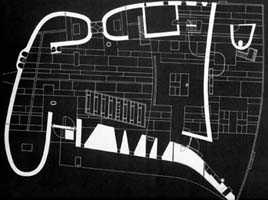
 |
marcos novak |
|
|
|
'transarchitectures
and hypersurfaces
:lles operations de la 'transmodernité' |
 |
 |
"i
will revise Le Corbusier: not 'Architecture
is a machine to live in', but '(trans)Architecture is an algorithm to
play in'. And, playfully, proclaim: transarchitectures and revolutions.
Round and round we go: In girum imus nocte et consumimur
igni."
|
|
|
a.
data-driven forms
|
| novak |
liquid architectures in cyberspace |
1995 |
| 10.
art is the roadbuilding habit (Zeno).
It ruptures,then rebuilds, the edge of thought. 09. architecture is the art of elaboration of inhabitable space. 08. elegance is the achievement of maximal effect with minimal effort. 07. both cyberspace and bodyspace arereal and physical, and both are inextricably intertwined with the virtual. 06. cyberspace isconstituted by information technologies;bodyspace is augmented by information technologies. 05. immersion is the transition from bodyspace to cyberspace; eversion is the transition cyberspace to bodyspace. |
 |
04. space
and time are no longer separate, not even in an every day sense: a space-time
vernacular has developed. |
|
|
cyberspace permits isomorphisms
between the conceptual and the perceptual and the objective and the subjective.
|
|||

|

|
|
|
the algorithm
that produces these forms works as follows: data is interpreted as two
sets of points in 3D space.
|
in bodyspace, an instance of output of the algorithm becomes a form of a material architecture... |
 |
 |
 |
|
|
|
 |
|
||||
 |
 |
|
by 'liquid' I mean involving the total but rigorous variability and the idea that formcan be driven by both data and presence, both when we are immersed in information and when information is everted on to the physical world. by 'algorithmic'I mean both created by the algorithms and subject to a self-imposed principle of minimal manual intervention. |
|
|
Part
two - Oosterhuis + Spyubroek
|
|
Part
three - Is (trans)architecture architecture?
|
|
||||||
|
||||||